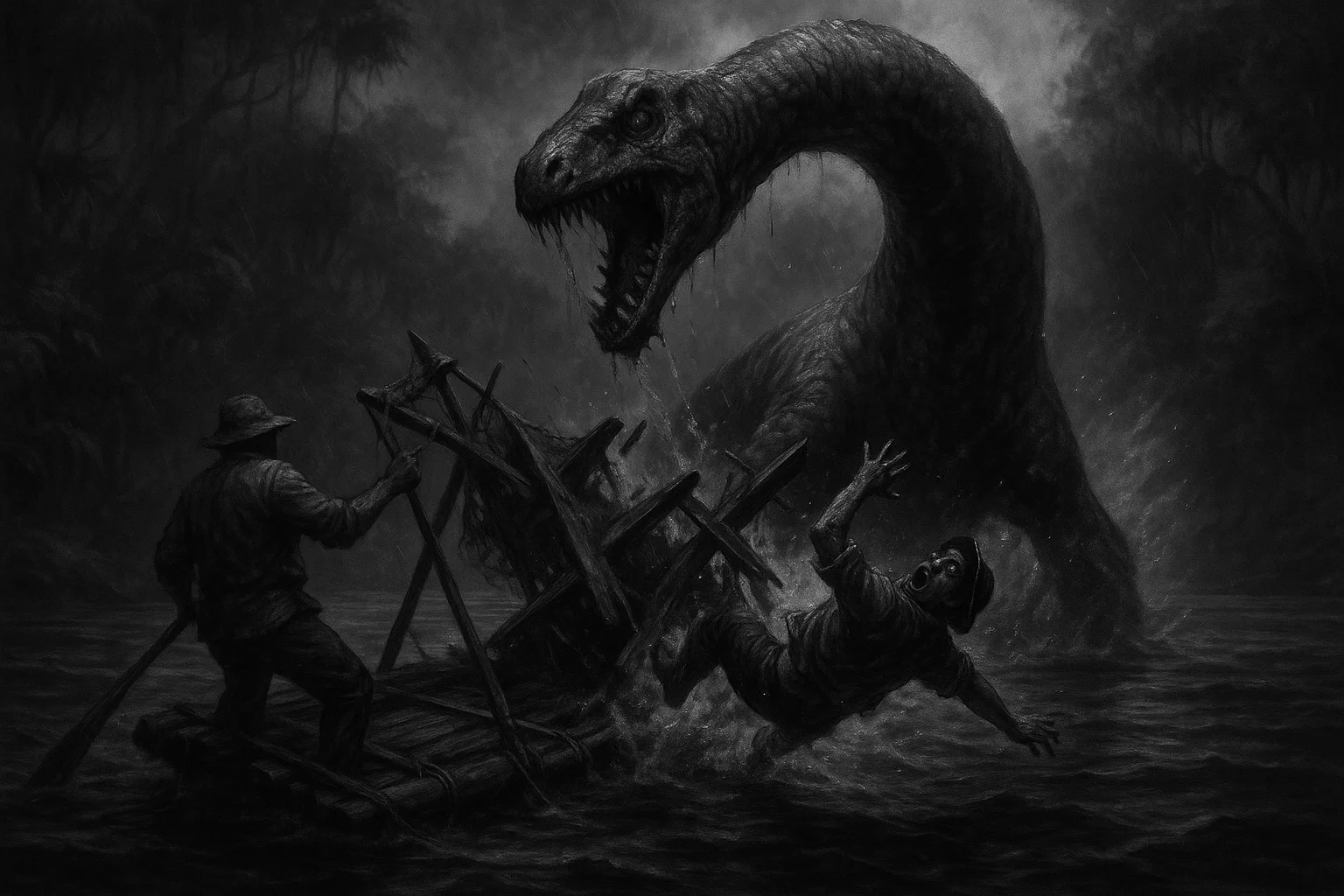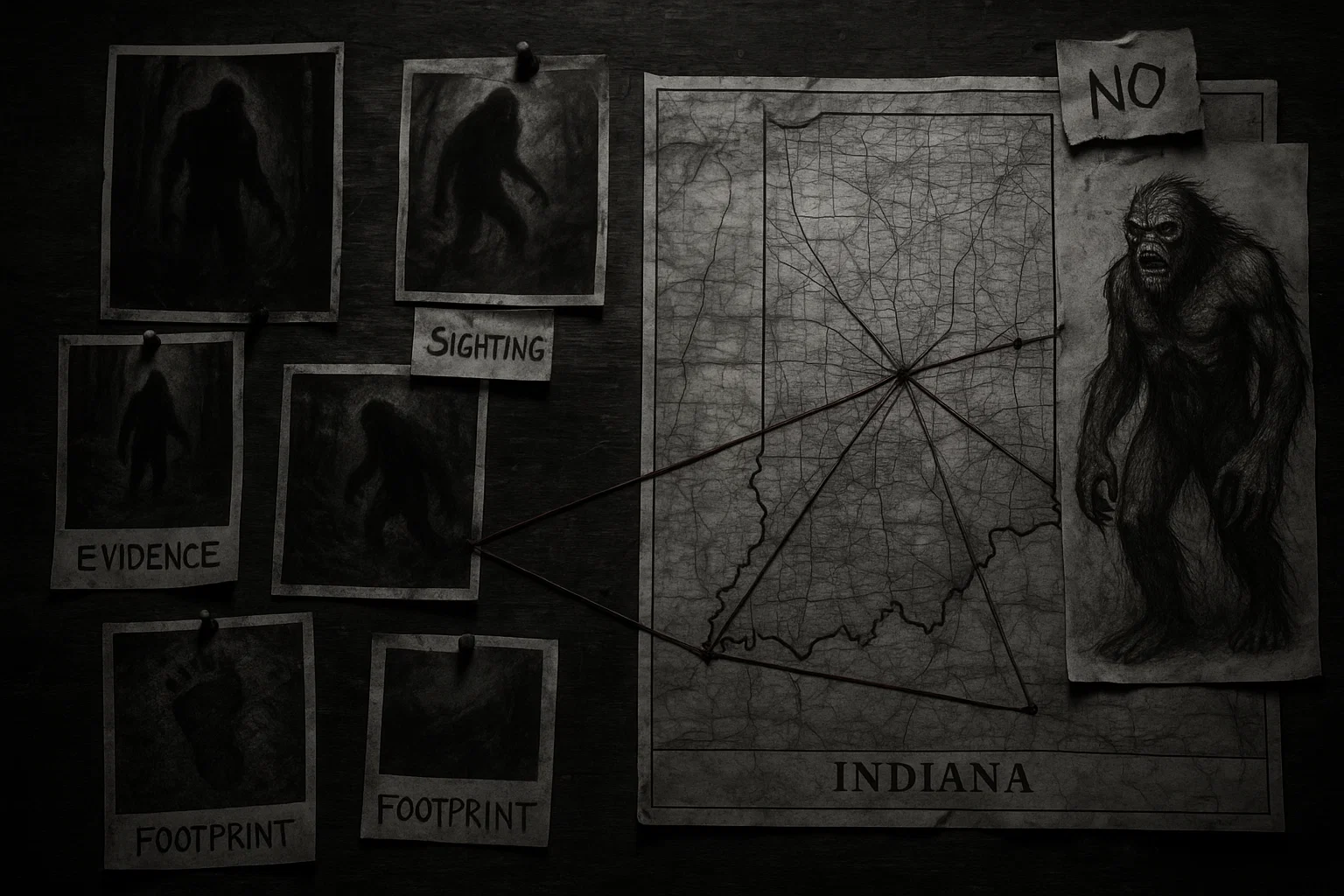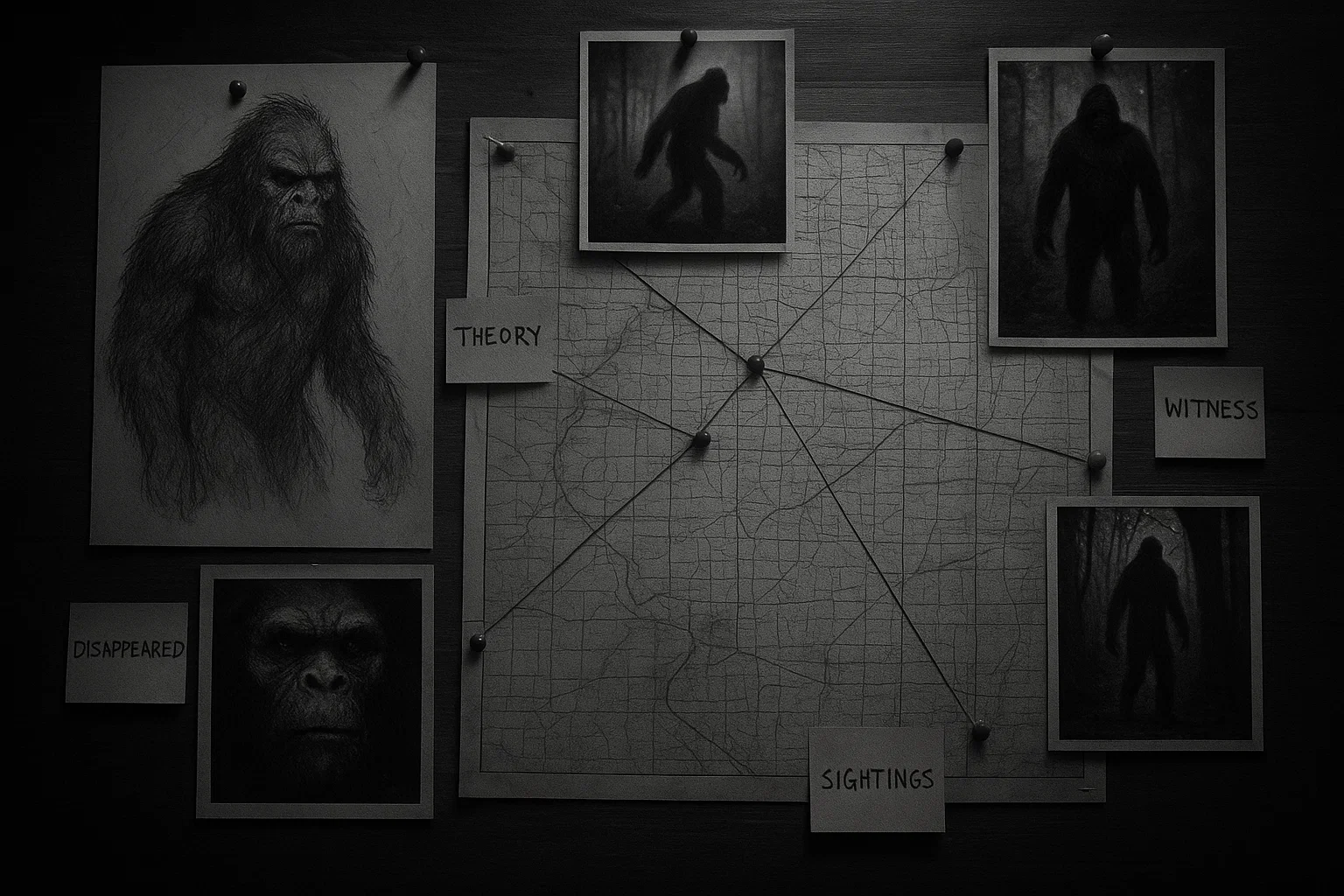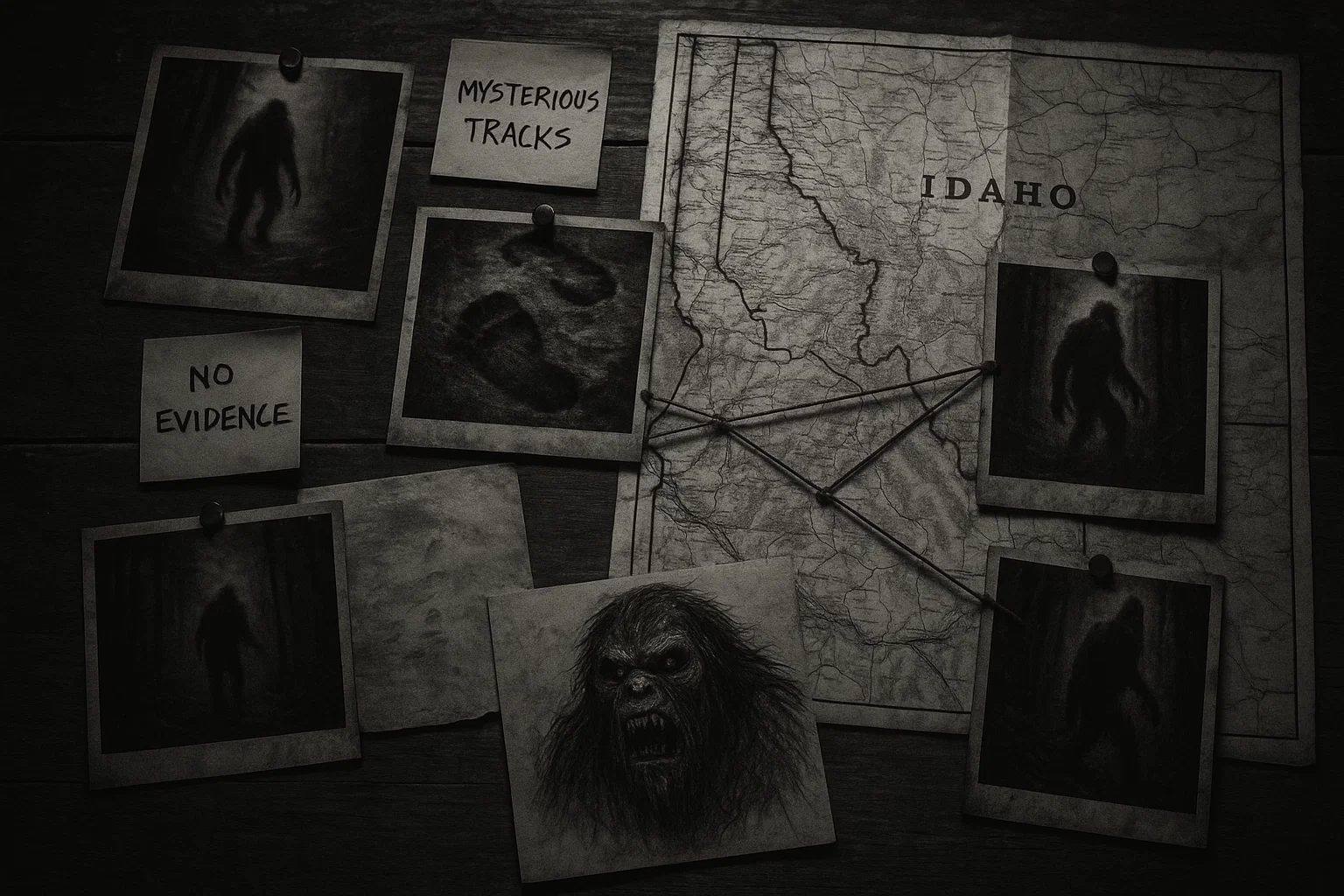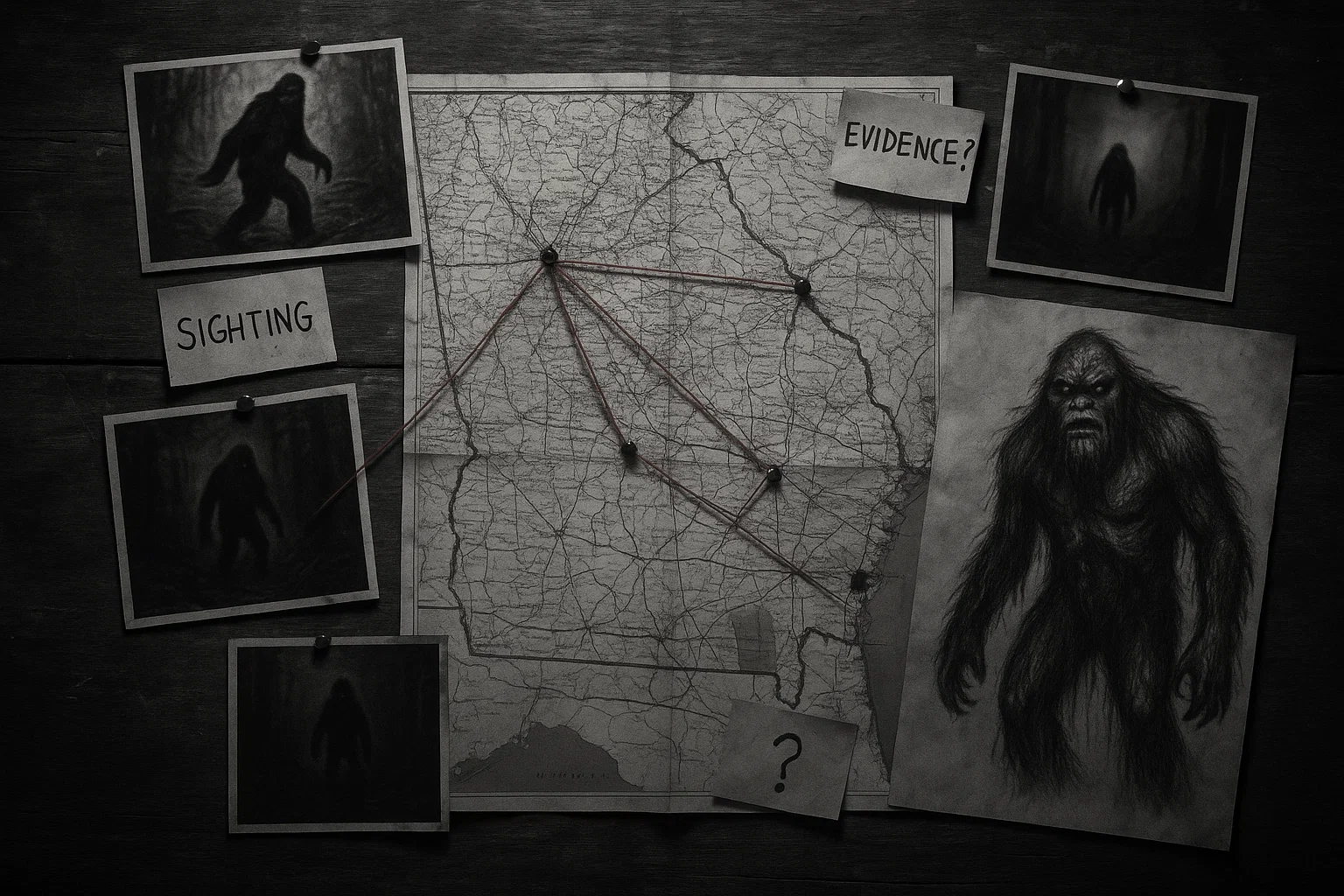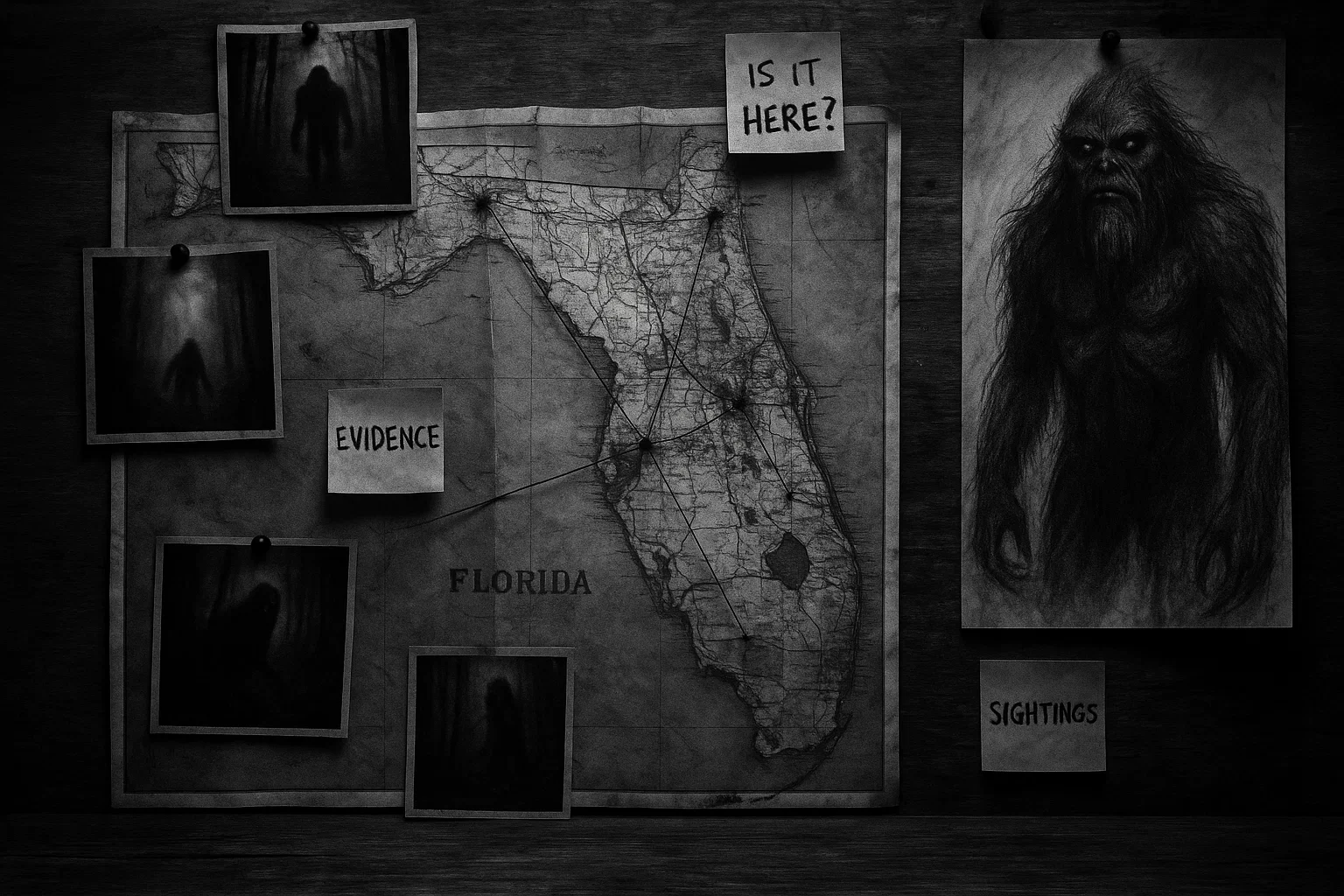Deep within the impenetrable swamps of the Congo River Basin, a legend persists that has captivated explorers, scientists, and cryptozoology enthusiasts for centuries: the Mokele-mbembe.
Known as the “one who stops the flow of rivers” in the Lingala language, this cryptid is said to resemble a sauropod dinosaur, a creature thought extinct for 66 million years. With its reported long neck, massive body, and elusive nature, Mokele-mbembe has sparked countless expeditions, debates, and stories of a living dinosaur lurking in Africa’s wild heart.
Is it a surviving prehistoric relic, a misidentified animal, or a myth woven into the fabric of local folklore?
Table of Contents
What Is Mokele-mbembe?
Mokele-mbembe is a legendary creature believed to inhabit the remote waterways and swamps of the Congo River Basin, primarily in the Republic of the Congo, Cameroon, and parts of Zambia.
Its name, derived from the Lingala phrase meaning “one who stops the flow of rivers,” reflects its supposed ability to disrupt water flow in rivers and lakes, often linked to its massive size and territorial behavior.
Described as a large, amphibious creature, Mokele-mbembe is frequently compared to sauropod dinosaurs like Brachiosaurus or Apatosaurus due to its long neck, small head, and bulky body.
Local Bantu and Pygmy tribes, including the Aka and Bangombe, have shared oral traditions about this creature for generations, describing it as both a physical entity and, in some cases, a spiritual being.
The legend gained traction in the West during the early 20th century, fueled by colonial explorers and missionaries who documented Indigenous stories.
Unlike other cryptids like Bigfoot or the Loch Ness Monster, Mokele-mbembe has been heavily associated with cryptozoology and, controversially, Young Earth creationism, as some expeditions aimed to find evidence of a living dinosaur to challenge evolutionary timelines.
Despite its prominence in cryptozoological circles, no definitive proof has been found, making Mokele-mbembe a subject of fascination, skepticism, and debate. Its elusive nature, combined with the Congo’s vast, unexplored terrain, keeps the legend alive, with reports suggesting it feeds on molombo plants and avoids human contact unless provoked.
You May Also Like: The Conjured Chest: 17 Victims, One Sinister Curse
What Does Mokele-mbembe Look Like?
Eyewitness accounts describe Mokele-mbembe as a formidable creature, roughly the size of an elephant or hippopotamus, with a body length of 15 to 30 feet.
Its most striking feature is a long, flexible neck, often extending 6 to 10 feet, topped with a small, snake-like head. The creature’s body is bulky, supported by four sturdy legs, and its skin is smooth, leathery, and typically brownish-gray, though some reports mention reddish-brown or greenish hues.
A long, muscular tail, likened to an alligator’s, completes its reptilian appearance. Some accounts note a single horn or tooth protruding from its head, while others describe a frill or crest along its neck or back, reminiscent of certain dinosaur reconstructions.
Its herbivorous diet, primarily consisting of molombo plants and liana fruits, distinguishes it from predatory cryptids. Locals report that it moves with a slow, deliberate gait on land but is agile in water, often submerging to avoid detection.
These consistent descriptions across tribes and regions have led some to speculate that Mokele-mbembe resembles a sauropod dinosaur, though its reported aquatic habits and lack of scales set it apart from typical dinosaur profiles.
Habitat
The Mokele-mbembe is primarily associated with the Congo River Basin, a sprawling 1.5 million-square-mile rainforest that ranks as the world’s second-largest, after the Amazon.
This biodiverse region, often called the “lungs of Africa” for its role as a carbon sink, encompasses dense jungles, slow-moving rivers, and vast swamps that provide ideal cover for a creature seeking to remain hidden.
The Likouala region and Lake Tele in the Republic of the Congo are the epicenters of Mokele-mbembe sightings, with additional reports from Cameroon’s Kasai Basin, Zambia’s Lake Bangweulu, and the Democratic Republic of the Congo’s Uele Basin.
These areas feature clay-lined riverbanks with caves, dense molombo plant growth, and murky waters, creating a perfect habitat for an amphibious creature.
The Congo Basin’s inaccessibility, with over 49,000 square miles of swampy terrain in Likouala alone, has preserved its mystique as a “lost world.”
Local tribes report that Mokele-mbembe inhabits deep pools and river bends, emerging to feed during the day and retreating to underwater caves at night.
The region’s minimal human activity, coupled with its rich biodiversity—including elephants, hippos, and crocodiles—supports the idea that an undiscovered species could survive undetected.
You May Also Like: The Gold of Tolosa: History’s Most Cursed Treasure?
Connection to Other Paranormal Events and Cryptids
The Congo Basin is a hotbed for paranormal and cryptozoological phenomena, with Mokele-mbembe being just one of many reported creatures.
Other cryptids in the region include the Emela-ntouka, a horned, rhinoceros-like creature; the Nguma-monene, a serpentine beast with a crocodilian head; and the Mbielu-mbielu-mbielu, described as a stegosaur-like creature with dorsal plates.
The Jba-Fofi, a giant spider allegedly reaching 5 feet in diameter, and the Dodu, a serpentine creature with a prehensile tail, are also part of local lore.
Historically, the Congo has been viewed through a colonial lens as a “prehistoric” land, a perception that fueled early 20th-century fascination with living dinosaurs.
The region’s dense forests and lack of Western exploration until the 19th century contributed to its reputation as a haven for the unknown. Local legends often blend physical and spiritual elements, with some tribes viewing Mokele-mbembe as a spirit guardian rather than a flesh-and-blood creature.
This spiritual dimension aligns with other African folklore, where animals are imbued with mystical significance, potentially linking Mokele-mbembe to broader paranormal narratives about forest spirits and ancestral protectors.
Mokele-mbembe Sightings
Sightings of Mokele-mbembe date back centuries, with accounts from Indigenous tribes and Western explorers forming a complex narrative:
| Date | Location | Witness/Investigator | Details |
|---|---|---|---|
| 1776 | Congo River Region, Republic of the Congo | Abbé Liévin-Bonaventure Proyart | Observed enormous footprints, ~3 feet in diameter with claw marks, no direct sighting. |
| 1909 | Lake Bangweulu, Zambia | Lt. Paul Gratz | Reported a creature called Nsanga, resembling a sauropod, based on local legends. |
| ~1924–1933 | East of Ouesso, Sanga River, French Congo | Robert Lehuard | Saw a 10m-long creature fighting a crocodile, long neck and tail, reddish-brown hue. |
| 1932 | Upper Cross River, Mamfe Pool, Cameroon | Ivan T. Sanderson, Gerald Russell | Observed a hippo-sized head, vast tracks, trampled grass, chewed liana fruits. |
| ~1935 | Likouala-aux-Herbes River, near Epena | Firman Mosomele | Saw a red-colored animal, 6′-8′ neck, snakelike head, brownish back, submerged quickly. |
| 1948 | Near Epena, Republic of the Congo | Mouassiposso | Saw creature wading across river twice, 10m away, consistent features with other reports. |
| 1948 or 1949 | Lake Barombi Mbo, Kumba, Cameroon | A. S. Arrey | Saw male and female, male neck 12′-15′ above water, viper-like scales, horn 8″ long, visible for 1 hour. |
| 1959 | Lake Tele, Republic of the Congo | Bangombe Tribe, Eugene Thomas | Trapped and killed a creature with a spiked fence, those who ate it died, stakes 15cm diameter. |
| ~1960s | Upper Likouala-aux-Herbes, between Mokengi and Bandeko | Nicolas Mondongo | Saw a 10m-long creature, neck thick as thigh, reddish-brown, frill like rooster comb. |
| 1963 | Northern DR Congo, marshy area | J. M. Lefebvre | Observed a grayish mass, 20′-40′ high, ~30′ neck, small head, 2′-3′ wide footprints. |
| ~1978 | Likouala-aux-Herbes River, upstream from Epena | David Mambamlo | Saw neck and head 10m away, rose 2m, greyish, snakelike head, no hair/scales. |
| 1980 | Likouala Region, Republic of the Congo | Roy Mackal, James Powell | Collected eyewitness accounts, no direct sighting, reported consistent descriptions. |
| 1981 | Likouala River, north of Epena | Roy Mackal Expedition | Observed a large wake ~5″ high, guides identified as Mokele-mbembe, no direct sighting. |
| 1981 | Lake Tele, Republic of the Congo | Herman and Kia Regusters | Multiple sightings: perturbations, neck visible, dark-brown, smooth skin, vocalizations recorded. |
| 1983 | Lake Tele, Republic of the Congo | Marcellin Agnagna | Saw creature for 20 minutes, long neck, small head, film failed to develop. |
| 1992 | Lake Tele, Republic of the Congo | Japanese Expedition | Captured video of a creature, later speculated to be an elephant with trunk raised. |
| 2001 | Kouilou Region, Republic of the Congo | Crypt Safari Crew | Documented footprints and local stories, no direct sighting. |
| 2003 | Odzala-Kokoua National Park, Republic of the Congo | Selah Abong’o | Mistook a forest elephant for Mokele-mbembe, attributed to poor visibility. |
| 2009 | Kouilou Region, Republic of the Congo | BBC Expedition | Found intriguing footprints, no direct sighting, collected local accounts. |
| 2016 | Likouala Swamp, Republic of the Congo | South African Documentary Crew | Interviewed Aka villagers, some believed creature died a decade ago, no direct sighting. |
| 2018 | Lake Tele, Republic of the Congo | Adam Christoffer Knuth | Found new algae species, no Mokele-mbembe sighting, collected local stories. |
1776: Abbé Liévin-Bonaventure Proyart’s Footprint Discovery
In 1776, French missionary Abbé Liévin-Bonaventure Proyart ventured through the lush, untamed jungles near the kingdoms of Loango and Kakongo, now part of the Republic of the Congo and Angola.
While exploring along a quiet riverbank, he stumbled upon enormous footprints, each about three feet wide, with deep claw marks that hinted at a massive creature.
In his book Histoire de Loango, Kakongo, et autres royaumes d’Afrique, Proyart described these tracks as “monstrous,” unlike anything left by elephants or hippos. The prints, fresh and pressed into the soft, clay-like soil, suggested a creature had passed through recently.
Curious, Proyart spoke with local tribes, who shared tales of a fearsome, unknown beast responsible for the tracks. Though he never saw the creature, his account, written when dinosaurs were still unknown to science, marked one of the earliest Western records of what would later be called Mokele-mbembe.
The lack of a direct sighting leaves the story open to interpretation, but the vivid description of the footprints fueled early curiosity about a hidden giant in the Congo’s depths.
You May Also Like: The Eery Story of Edward Mordrake | Horror Story
1932: Ivan T. Sanderson and Gerald Russell’s Encounter at Mamfe Pool
In early 1932, during the dry season, Scottish biologist Ivan T. Sanderson and animal trader Gerald Russell were exploring the Upper Cross River in Cameroon as part of the Percy Sladen Expedition.
Their journey led them to Mamfe Pool, a calm, muddy stretch of river surrounded by dense forest. One morning, as they paddled in a canoe, a deafening roar—like an “on-coming earthquake or an exploding robot”—echoed from an underwater cave, startling the pair.
Moments later, a massive, dark-colored creature surfaced briefly, its head as large as a hippopotamus, with smooth skin and small eyes. The animal vanished quickly, leaving a powerful wake that rocked their canoe.
On shore, they found wide tracks, two to three feet across with claw-like marks, alongside trampled grass and chewed liana fruits with white blossoms, suggesting a plant-eating creature with a long neck.
Sanderson, a trained zoologist, insisted the tracks didn’t match any known animal, noting the absence of hippos in the area. He later shared the story in a 1958 letter to cryptozoologist Bernard Heuvelmans, who confirmed Russell’s agreement: “It was like Ivan tells it.”
The sighting, detailed and backed by Sanderson’s expertise, remains compelling, though the lack of photographs and its absence from his 1937 book Animal Treasure leaves some questions unanswered.
1959: Bangombe Tribe’s Alleged Killing at Lake Tele
Around 1959, the Bangombe tribe near Lake Tele in the Republic of the Congo’s Likouala region faced a problem: something was ruining their fishing nets. To protect their livelihood, they built a spiked fence across a narrow river channel using sturdy, 15cm-diameter wooden stakes.
One morning, a commotion erupted as a massive creature crashed through the barrier, wounding itself on the spikes. The villagers, armed with spears, killed the animal, which they described as having a long neck, a small head, and smooth, brownish-gray skin, stretching about 30 feet long.
After the kill, they held a victory feast, cooking and eating parts of the creature. Tragically, those who ate the meat fell ill and died, leading to local beliefs that Mokele-mbembe’s flesh is toxic.
American missionary Eugene Thomas, who had lived in the Congo since 1955, shared this story with cryptozoologists Roy Mackal and James Powell in 1979. Thomas noted that two Pygmy witnesses mimicked the creature’s cry—a loud, distressed bellow—during the attack.
When Mackal and Powell visited Lake Tele in 1980, they found remnants of the stakes still in the riverbed, adding a tangible clue to the tale.
Fisherman Mateka Pascal, a young witness to the event’s aftermath, told them, “All who ate of it died.” The story’s cultural weight and physical evidence make it striking, but its secondhand nature and lack of preserved remains leave room for doubt.
1981: Herman and Kia Regusters’ Expedition to Lake Tele
In September 1981, American aerospace engineer Herman Regusters and his wife, Kia Van Dusen, led the TRACE-1 expedition to Lake Tele, becoming the first Westerners to reach this remote, swampy lake. Over weeks of exploration, they reported several encounters with a mysterious creature.
One misty morning, while scanning the lake from their inflatable raft, they noticed unusual ripples and waves, unlike those caused by hippos or crocodiles.
Days later, near the clay-lined shore, they saw a long, dark-brown neck—about six feet high—rise from the water, topped with a small, snake-like head. The creature stared at them with a “reptilian gaze” for eight minutes before slipping silently beneath the surface, leaving a wide wake that suggested a body 20 to 35 feet long.
Toward the end of their trip, a loud roar echoed through the swamp at dusk, followed by the sound of a large animal crashing through vegetation near their camp.
The team recorded deep, rumbling vocalizations, unlike any known animal, and collected three-clawed footprint casts and droppings. Their photographs, however, were blurry, possibly showing a neck or just debris.
Regusters, in his 1981 report, wrote, “The creature looked for a few seconds… before silently sliding under the water.” These detailed observations, backed by audio evidence, make the expedition notable, but the lack of clear images and Regusters’ disputes with other researchers have sparked skepticism.
1983: Marcellin Agnagna’s Observation at Lake Tele
On May 1, 1983, Congolese biologist Marcellin Agnagna was conducting a survey near Lake Tele for the Ministry of Water and Forests when a guide’s shout drew his attention to the water.
At about 2:30 PM, under clear daylight, he spotted a creature 250 meters away in shallow water. It had a long, flexible neck, 1.6 to 3.3 meters tall, with a small, elongated head and a single tooth or horn. Its bulky, grayish-brown body, with smooth skin, moved slowly, occasionally lifting its neck to scan the area.
Agnagna watched for 20 minutes, estimating the creature’s length at 15 to 35 feet. He tried to film it with a Super 8 camera but later found the footage was blank, likely due to a forgotten lens cap or focusing error.
In his report, Agnagna wrote, “The body was reminiscent of a hippo’s, only more bulbous… informants invariably pointed to a picture of a sauropod.” He also spoke with elephant hunter Immanuel Mongoumela, who claimed three sightings since 1981, including one where the creature was eating vegetation.
Mongoumela showed Agnagna fresh tracks at a site previously noted by Roy Mackal.
As a trained scientist familiar with the Congo’s wildlife, Agnagna insisted the creature was unique, but his shifting details and lack of film have drawn criticism. The prolonged observation and local corroboration make this account significant, despite its flaws.
You May Also Like: What Is Momo the Monster? Missouri’s Creepiest Legend
1988: Japanese Expedition’s Video Footage
In February 1988, a Japanese film crew, guided by Congolese wildlife official Jose Bourges, set out to document Lake Tele for a television special.
While flying over the lake in a small plane, the cameraman spotted a disturbance in the water and filmed about 15 seconds of footage showing a wake and a moving object, possibly a long, neck-like structure. The entire team, including Bourges, reported seeing a large animal with a humped back gliding across the lake.
A Boha porter, who remained unnamed, told them he had recently seen a Mokele-mbembe enter the lake from a nearby river, aligning with local beliefs that the creature roams waterways like the Likouala-aux-Herbes. The footage, aired on Japanese television, caused a stir but was criticized for its grainy quality and distance.
Skeptics suggested it showed two men in a canoe, with one standing, or elephants swimming with raised trunks. A report noted, “The cameraman struggled to maintain focus on the object, which was creating a noticeable wake.”
The involvement of a wildlife official and local testimony adds some weight, but the ambiguous video and lack of clear details keep this sighting debated.
Evidence, Investigations, and Theories
Despite numerous expeditions, no definitive physical evidence—such as bones, clear photographs, or DNA—has confirmed Mokele-mbembe’s existence.
Footprint casts, like those collected by Herman Regusters in 1981, show large, three-clawed tracks, but their authenticity is debated. Sound recordings from the same expedition captured unusual bellows, distinct from known animals like hippos or crocodiles.
A 1993 photograph by Rory Nugent was later identified as a floating log, and 1992 Japanese footage is widely considered an elephant misidentification.
Over 50 expeditions since the 19th century, including those by Roy Mackal (1980–1981), Bill Gibbons (1992), and the 2009 BBC team, have yielded only anecdotal accounts and circumstantial evidence like trampled vegetation or large wakes.
You May Also Like: Who Is Seere? The 70th Demon of the Ars Goetia
Theories Explaining Mokele-mbembe
The Mokele-mbembe has inspired a range of theories to explain its existence. Theories range from a surviving prehistoric creature to misidentified animals, cultural folklore, an undiscovered species, or even African softshell turtles.
| Theory | Supporting Evidence | Challenges | Expert Opinion |
|---|---|---|---|
| Surviving Dinosaur | Resembles sauropod; remote Congo terrain | No fossils; dinosaurs extinct 65M years; creationist bias | Donald Prothero: Creationist-driven, lacks evidence |
| Misidentification of Animals | Black rhino, hippo, elephant sightings; 2003 elephant case | Lacks long neck, aquatic habits; detailed accounts don’t match | Mainstream: Likely black rhino; Heuvelmans: Possible hippo |
| Cultural Myth or Folklore | Consistent tribal stories; spiritual significance; colonial influence | Specific eyewitness details; some physical evidence (footprints) | Edward Guimont: Rooted in pseudohistorical claims |
| Undiscovered Species | Congo’s biodiversity; okapi discovery | No physical evidence; doesn’t match known reptiles | J. Richard Greenwell: Unlikely large herbivore |
| Softshell Turtle | Long neck; semi-aquatic; possible in low light | Too small; doesn’t match detailed accounts or behavior | Karl Shuker: Possible for vague sightings |
Surviving Dinosaur Theory
The most captivating theory posits that Mokele-mbembe is a living sauropod dinosaur, such as a Brachiosaurus or Apatosaurus, surviving in the Congo’s remote jungles.
Eyewitness accounts, like the 1959 Bangombe tribe’s report of killing a 30-foot-long creature with a long neck and small head, align with sauropod characteristics.
The Congo Basin’s vast, 1.5 million-square-mile rainforest, particularly the 49,000-square-mile Likouala swamp, is often cited as a potential refuge where such a creature could evade detection. Early 20th-century explorer Carl Hagenbeck, in his 1909 book Beasts and Men, speculated about living dinosaurs in Africa, fueling this theory. S
ome cryptozoologists, like Roy Mackal, who led expeditions in the 1980s, argued that the region’s isolation supports the possibility of a relic population.
However, this theory faces significant scientific challenges. Dinosaurs went extinct 65 million years ago, and no fossils or skeletal remains of sauropods have been found in the Congo.
Paleontologist Donald Prothero, in a 2013 Scientific American article, dismissed the idea, stating, “The quest for Mokele-Mbembe … is part of the effort by creationists to overthrow the theory of evolution and teaching of science by any means possible” (Scientific American).
He noted that “the only people looking for mokele-mbembe are creationist ministers, not wildlife biologists,” highlighting the theory’s ideological bias over scientific grounding. The ecological requirements of a sauropod—large food sources and a breeding population—would be difficult to sustain undetected in the Congo.
On Reddit’s r/Cryptozoology, users echo this skepticism, with one stating, “There’s no way a dinosaur could survive that long without being discovered” (Reddit).
Another user remarked, “The lack of evidence is deafening; it’s just not plausible.” The absence of physical proof and the scientific consensus on dinosaur extinction make this theory highly unlikely, despite its allure.
Misidentification of Known Animals
A more plausible theory suggests that Mokele-mbembe sightings are misidentifications of known animals, such as the black rhinoceros, hippopotamus, or forest elephant, all native to the Congo Basin.
The black rhinoceros, once prevalent in Central Africa, shares traits like a large body and a single horn, which could align with reports of a horned, bulky creature.
For instance, early 20th-century accounts, like Ludwig Freiherr von Stein zu Lausnitz’s 1913 report, described a creature with a horn-like feature. Mainstream experts, as noted in a Wikipedia entry, believe that Mokele-mbembe was likely inspired by the black rhinoceros, which thrived in the region until its population dwindled (Wikipedia).
Hippos and elephants, common in the Congo’s rivers and swamps, could also be mistaken for a large, aquatic creature, especially in low-visibility conditions like murky water or dense fog.
A 2003 sighting by conservationist Selah Abong’o in Odzala-Kokoua National Park was later identified as a forest elephant, reinforcing this theory.
However, this theory struggles to account for the consistent descriptions of a long, flexible neck and a small, snake-like head, as reported by witnesses like Marcellin Agnagna in 1983, who explicitly ruled out hippos, crocodiles, and manatees.
Rhinos, hippos, and elephants lack these features, and their terrestrial or semi-aquatic behaviors don’t fully match the reported aquatic habits of Mokele-mbembe, such as submerging in deep pools or living in riverbank caves.
Cryptozoologist Bernard Heuvelmans suggested that some sightings could involve hippos, but he acknowledged that detailed accounts point to something distinct.
On Reddit, users explore this idea, with one noting, “In low light, an elephant or hippo could easily be misidentified” (Reddit). Another user suggested, “Maybe it’s just a big monitor lizard or something similar, seen from a weird angle.” While misidentification explains some sightings, it falls short for those with specific, sauropod-like details, making it a partial but not complete explanation.
You May Also Like: Impundulu: The Strange Bird That Drinks Blood
Cultural Myth or Folklore
Another compelling theory is that Mokele-mbembe is a cultural myth or folklore, rooted in the Congo Basin’s rich oral traditions among tribes like the Bangombe and Aka.
Anthropologist Pierre Alexandre, in 1960, noted that some Congolese described Mokele-mbembe as a “giant crocodile,” while others viewed it as a spiritual entity, suggesting a symbolic rather than physical creature.
The Boha Village, for example, considers it a spirit guardian, not a flesh-and-blood animal. Historian Edward Guimont argues that the myth grew from earlier pseudohistorical claims about Great Zimbabwe, later amplified by colonial views of Africa as a “prehistoric” land (Wikipedia).
This theory is supported by the consistency of descriptions across tribes, such as a long-necked, herbivorous creature, which points to a shared cultural narrative. A 1980s carving documented by Roy Mackal, depicting a long-necked, long-tailed animal, reflects this cultural significance.
Yet, some eyewitness accounts, like Ivan T. Sanderson’s 1932 sighting of a creature with a hippo-sized head and large tracks, provide specific details that seem too vivid for a purely mythical figure.
Physical evidence, such as footprint casts from Herman Regusters’ 1981 expedition, also suggests a tangible basis for the legend.
Undiscovered Species
Some cryptozoologists propose that Mokele-mbembe could be an undiscovered species, perhaps a large reptile or monitor lizard adapted to the Congo’s unique ecosystem.
The Congo Basin’s vast, biodiverse terrain—home to species like the okapi, discovered in 1901—supports the idea that unknown megafauna could exist.
Roy Mackal, in his book A Living Dinosaur? (1987), suggested that Mokele-mbembe might be a relic reptile, possibly related to extinct archosaurs. The creature’s reported herbivorous diet, feeding on molombo plants, and its aquatic habits align with a specialized niche in the Congo’s swamps.
However, the absence of physical evidence, such as bones, DNA, or clear photographs, weakens this theory. The creature’s described size (15–30 feet) and sauropod-like features don’t match any known reptiles, and monitor lizards, while large, rarely exceed 10 feet.
Biologist J. Richard Greenwell, in a 1983 interview, noted that while the Congo’s biodiversity is vast, “the idea of a large, unknown herbivore is unlikely” due to the lack of ecological traces like widespread tracks or feeding sites.
Over 25 expeditions since 1980, including those by Mackal and Bill Gibbons, have found no conclusive proof.
Softshell Turtle Theory
A less common theory suggests that Mokele-mbembe might be an African softshell turtle (Trionyx triunguis), which can grow to a carapace length of over 90 cm and has a long, flexible neck.
Cryptozoologist Karl Shuker proposed that some sightings, particularly those in dim light or murky water, could involve these turtles, whose necks might resemble a small head on a long neck when basking.
A Reddit user in r/Cryptozoology supported this, noting, “Softshell turtles are quite huge, and in low light, they could be mistaken for something bigger” (Reddit). Their semi-aquatic nature aligns with reports of Mokele-mbembe submerging in rivers or lakes.
However, softshell turtles are far smaller than the 15–30-foot creature described in many accounts, and their behavior—primarily basking or scavenging—doesn’t match the reported territorial or herbivorous traits.
Marcellin Agnagna’s 1983 sighting, which described a bulky, 35-foot-long creature, explicitly ruled out turtles. Most experts, including Shuker, limit this theory to less detailed sightings, as it fails to explain the more elaborate accounts.
Another Reddit user commented, “Turtles could explain some reports, but not the ones describing a 30-foot creature.” This theory offers a plausible explanation for minor sightings but falls short for the majority of Mokele-mbembe reports.
Most Likely Explanation
The evidence leans toward the misidentification of known animals and cultural myth theories as the most plausible explanations for Mokele-mbembe.
The black rhinoceros, hippo, or elephant misidentification accounts for many sightings, especially in low-visibility conditions, as supported by cases like Selah Abong’o’s 2003 elephant sighting.
The cultural myth theory, backed by anthropologists like Pierre Alexandre and historians like Edward Guimont, aligns with the Congo’s storytelling traditions and colonial influences, explaining the legend’s consistency and spiritual elements.
The surviving dinosaur and undiscovered species theories, while intriguing, lack physical evidence and face significant scientific barriers. The softshell turtle theory applies only to vague sightings, not the detailed accounts of a large, sauropod-like creature.
Without bones, clear images, or DNA, Mokele-mbembe remains a blend of folklore, misperception, and the enduring allure of the Congo’s unexplored wilderness.
You May Also Like: Crowing Crested Cobra: A Real-Life Basilisk or Folklore Beast?
Comparison with Other Similar Cryptids
Mokele-mbembe shares traits with other aquatic or long-necked cryptids, often likened to plesiosaurs or sauropods:
| Cryptid Name | Location | Key Sightings | Likelihood of Existence |
|---|---|---|---|
| Loch Ness Monster | Loch Ness, Scotland | 1933: George Spicer saw a creature crossing a road; 1934: Surgeon’s Photograph (later debunked); 1975: sonar detected large objects. | Low: Sonar and photos inconclusive; likely misidentified seals or logs. |
| Champ | Lake Champlain, USA/Canada | 1883: Sheriff Nathan Mooney saw a 25-foot creature; 1977: Sandra Mansi’s photo showed a neck-like shape; 2003: sonar detected anomalies. | Moderate: Mansi’s photo is debated; could be otters or sturgeons. |
| Ogopogo | Okanagan Lake, Canada | 1872: Susan Allison reported a serpentine creature; 1980: multiple witnesses saw humps; 2011: video showed a moving object. | Moderate: Videos are unclear; possibly large fish like sturgeon. |
| Manipogo | Lake Manitoba, Canada | 1948: C. P. Alarie saw a “snake-like” creature; 1962: multiple witnesses reported a humped animal; 1997: brief video sighting. | Low: Limited evidence; likely fish or wave patterns. |
| Memphre | Lake Memphremagog, USA/Canada | 1816: early settler reports of a sea serpent; 1994: diver saw a large creature; 2000: tourist reported a neck-like shape. | Low: Few detailed reports; possibly large fish or debris. |
| Chessie | Chesapeake Bay, USA | 1982: Robert Frew’s video showed a serpentine shape; 1995: multiple boaters saw humps; 2014: photo of a dark object surfaced. | Moderate: Video evidence exists but is inconclusive; could be manatees or waves. |
| Longneck Sea Serpent | Various oceans (e.g., Atlantic, Pacific) | 1848: HMS Daedalus crew saw a 60-foot serpent; 1905: Victory ship reported a humped creature; 2009: Alaska sighting of a neck-like shape. | Low: Often explained as oarfish or wave illusions. |
| Issyk-Kul Monster | Lake Issyk-Kul, Kyrgyzstan | 1880s: Russian settlers reported a serpent; 1960s: divers saw a large shape; 2007: tourist photo showed a vague form. | Low: Likely large fish or local myth exaggeration. |
| Liopleurodon | Amazon River (hypothetical) | No confirmed sightings; based on speculation and Amazon river monster tales. | Very Low: Purely speculative; no credible reports. |
| Storsjöodjuret | Lake Storsjön, Sweden | 1635: first recorded sighting; 1894: photo attempt failed; 2008: underwater cameras detected anomalies. | Moderate: Ongoing searches; possibly large pike or logs. |
| Seljordsormen | Lake Seljord, Norway | 1750: early reports of a serpent; 1977: divers saw a large shape; 2001: video showed humps. | Low: Videos inconclusive; likely fish or natural phenomena. |
| Nguma-monene | Congo River Basin, Republic of the Congo | 1961: Joseph Ellis reported a long, scaled creature; 1970s: missionary accounts of a river serpent; 2006: local fisherman sighting. | Moderate: Shares Mokele-mbembe’s region; possibly a large snake or crocodile. |
Analysis and Insights
Globally, lake-based cryptids like the Loch Ness Monster, Champ, and Ogopogo share the aquatic, long-necked archetype but are tied to colder, temperate lakes rather than tropical rivers.
Their cultural significance—often as spiritual or tourism icons—parallels Mokele-mbembe’s role in Bantu folklore, yet their plesiosaur-like imagery contrasts with the sauropod comparison.
The Longneck Sea Serpent and Liopleurodon lean toward marine reptile theories, differing from Mokele-mbembe’s freshwater, herbivorous profile.
Less-documented cryptids like Manipogo and Memphre lack the depth of sightings associated with Mokele-mbembe, while Storsjöodjuret and Seljordsormen are steeped in European folklore, contrasting with the Congo’s spiritual narratives.
The Issyk-Kul Monster shares a remote lake habitat but lacks detailed reports. Likelihood of existence varies, with most cryptids rated low to moderate due to inconclusive evidence, often explained by misidentified animals (e.g., seals, sturgeons, or crocodiles) or natural phenomena.
Mokele-mbembe’s unique tropical river setting and sauropod-like descriptions set it apart, but like its counterparts, it remains unproven, fueling ongoing fascination with these enigmatic creatures.
Is Mokele-mbembe Real?
The Mokele-mbembe legend endures due to the Congo Basin’s vast, unexplored terrain and humanity’s fascination with living dinosaurs.
However, the absence of verifiable evidence—despite over 50 expeditions—suggests it is likely a myth rooted in cultural folklore or misidentifications of known animals like rhinos, elephants, or large reptiles.
The cultural myth theory, supported by consistent oral traditions and the lack of physical remains, is the most credible explanation. Deforestation, which has reduced the Congo’s forest cover by nearly 10% since 2002, may increase wildlife encounters, fueling modern sightings that are likely mistaken identities.
While the possibility of an undiscovered species cannot be entirely dismissed, the balance of evidence points to Mokele-mbembe as a captivating legend rather than a real creature, embodying the allure of the unknown in one of Earth’s last wild frontiers.

